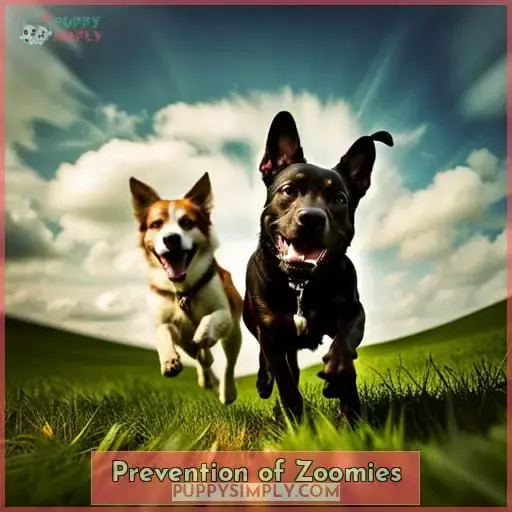This site is supported by our readers. We may earn a commission, at no cost to you, if you purchase through links.
Do you ever witness your dog running around erratically and wonder why? While it is natural for dogs to have bursts of energy known as zoomies, in some cases, the behavior can be a sign of underlying issues.
It’s important to understand what could be causing this type of behavior so that proper steps can be taken for prevention or treatment. In this article, we will explore the possible causes and preventative measures when it comes to dogs running around erratically.
Table Of Contents
Key Takeaways
- Dogs running around erratically, also known as zoomies, are common in puppies and can be comical but also worrisome if not managed properly.
- Zoomie triggers are usually overexcitement or pent-up energy in young dogs.
- Redirecting excess energy towards toys, using a short lead outside, and increasing physical exercise and mental stimulation can help manage zoomies.
- Zoomies can sometimes take on an aggressive attitude, especially in older dogs, and may require professional help to address underlying causes such as cognitive decline or anxiety.
What Are Dog Zoomies?
You may have seen your pup randomly burst into a flurry of energy and activity, like an athlete on the starting block.
Zoomie Triggers are usually related to overexcitement or pent-up energy in young dogs. Signs of Zoomies include running around the house or frantically circling in one spot, barking, jumping up onto furniture, etc.
The duration of these episodes varies greatly depending on individual breeds and age groups – from seconds to minutes at a time.
Puppy zoomies tend to occur more frequently due to their higher level of activity compared with older dogs who generally outgrow them as they mature. Zoomie Solutions involve redirecting their excess energy towards toys, using a short lead when outside, and increasing physical exercise coupled with mental stimulation.
Frequency varies widely between each dog based upon many factors including breed type combined with diet & lifestyle habits, so there is no definitive answer here, unfortunately! In addition, social media provides a great platform for sharing tips & experiences pertaining to this topic via the #PethoodStories hashtag, which might prove useful for further insights into zoomie behavior patterns amongst different breeds!
Causes of Zoomies
Greeting pet owners everywhere! Zoomies, or FRAP (Frenetic Random Activity Period) attacks, are random bursts of high activity and energy in dogs. Common causes for these episodes include overexcitement and pent-up energy in puppies.
While zoomies can be comical to observe from a distance, it is important to remember that managing the underlying issues can help prevent future occurrences.
Overexcitement
Feeling overwhelmed with excitement can lead your pup to display zoomie behavior. These random bursts of energy, also known as FRAP (Frenetic Random Activity Period) attacks, are most common in puppies due to overexcitement and pent up energy.
Zoomies often involve running around the house or frantic circles, barking, and jumping on furniture – all signs that they need an outlet for their seemingly endless energy! Redirecting this excess adrenaline rush with exercise routines and mental stimulation is key to helping them manage it better – socialization strategies such as playtime with other dogs have proven effective too.
Natural remedies like calming treats may be beneficial when reducing stress levels; however, older dogs exhibit similar behaviors, so it’s important to consider underlying medical issues before attempting any remedy at home! For a beloved dog who exhibits these symptoms regularly, proper exercise coupled with adequate mental stimulation should become part of a regular care routine for optimal health and wellbeing over time.
Pent Up Energy
When your pup’s energy has been pent up too long, it can lead to bursts of activity that seem uncontrollable.
- Establishing consistent exercise habits like daily walks or outdoor activities is the best medicine for preventing these episodes.
- Playtime with other dogs helps release any built-up anxiety, while diet changes may also help reduce stress levels in some cases.
- Mental stimulation, such as puzzle toys and obedience training, provides an intellectual challenge which may prevent bouts of zoomies from occurring frequently.
Adequate physical exercise combined with regular mental stimulation is essential for maintaining a healthy balance in energetic puppies.
Aggressive Zoomies
As exciting as they might be, zoomies can sometimes take on an aggressive attitude. Even in older dogs that have outgrown the puppy phase, age-related changes such as cognitive decline or anxiety could be causing this behavior.
It’s important to understand and manage underlying causes if your dog exhibits any of these behaviors so that you can provide the best care for them moving forward.
Your pup’s overall energy level should also be taken into consideration when managing zoomies. Puppies tend to need more exercise than senior dogs do since they’re still growing and developing physically and mentally.
It may seem overwhelming at first, but with patience and dedication from pet owners everywhere, we can prevent further occurrences by understanding our furry friend’s needs better.
Prevention of Zoomies
You can help prevent zoomies in your pup by providing them with proper exercise and mental stimulation. It’s important to tailor an exercise plan that fits the needs of both you and your pet, taking into account age, breed, health issues, etc.
For senior dogs, especially those who may be suffering from Cushing’s Syndrome or other ailments, these need to be taken into consideration when creating a program for them. Mental stimulation should also become part of their daily routine. Positive reinforcement training is always encouraged as it gives owners a chance to bond with their furry friends while teaching them basic commands like sit or stay.
Other activities, such as socialization tips (meeting new people/animals), will also benefit pups in the long run.
Though the most common causes of zoomies tend to stem from overexcitement or pent up energy during puppyhood, appropriate exercise plays an essential role throughout our pet’s life cycle, no matter what stage they’re at right now! Pet owners everywhere should take this seriously because not only does it provide physical benefits but emotional ones too, helping us better understand our fur babies’ unique personalities so we can give even more love and care than ever before!
Senior Dog Pacing
Greetings! Pacing is a common behavior that many senior dogs exhibit. It can be caused by cognitive decline, brain ailments, and pain. To better understand why this occurs in older canines and what we as pet owners can do to help them out, it’s important to become aware of these causes and the associated treatments for each one.
Cognitive Decline
Caring for a senior pup can come with its own set of challenges, especially when it comes to changes in behavior due to cognitive decline. Symptoms such as pacing and circling can be signs of canine cognitive dysfunction or age-related loss of cognitive function.
Treatment options may include medication, food supplements, mental stimulation, and memory foam dog beds. Normal cognitive decline is expected with aging, but if symptoms persist, then pet owners should consult their veterinarian for further assessment.
Brain Ailments
Be aware that brain ailments can cause your pup to pace erratically. Symptoms such as circling or increased panting may indicate serious health issues and should be checked out by a vet.
As dogs age, cognitive abilities decrease due to aging effects, and the clinical version of canine cognitive decline is more common than previously thought. So, early detection is key in treating brain tumors or other neurological conditions.
Treatment options include medication, food supplements, mental stimulation activities with friends and family members for socialization purposes. Memory foam dog beds can also help ease joint pain associated with these illnesses.
Remember that proper care will ensure your pet has the best quality of life possible!
Pain
Pain can be an underlying cause of your pup’s erratic behavior, yet it doesn’t have to mean the end of playtime. With early intervention and pain relief measures, many joint problems or heart disease can be managed properly.
Cognitive decline is another issue that needs to be addressed with anxiety management techniques and improved sleep quality.
Urinary control might also suffer in senior dogs due to urinary tract infection or joint pain that requires special attention from a veterinarian.
To make sure your pup enjoys their golden years in comfort: pay attention for signs of discomfort, seek professional help when necessary, provide proper medication/supplements if needed, and create an environment full of mental stimulation!
Circling in Senior Dogs
Circling can be a sign of anxiety in your senior pup, and it may also indicate underlying cognitive issues or medical conditions. Age-related causes, such as canine cognitive dysfunction, are common for older dogs.
That’s why it’s important to understand the effects that anxiety has on their behavior and how you can help them manage the condition.
Treatment options may include medications, food supplements, and mental stimulation activities like puzzle toys or walks with lots of sniffing opportunities – all tailored to each individual dog’s needs.
Sleep habits should be monitored too. Changes from their normal pattern could point towards possible problems caused by age-related health concerns, such as dementia or other cognitive issues. If any strange behaviors become evident, consulting with a veterinarian for advice would be beneficial.
They can identify any potential underlying health problems causing it before attempting treatment at home.
As pet owners, we must remain alert when observing our senior dog’s behavior in order to detect signs early on if something isn’t quite right.
Panting in Senior Dogs
Panting in your senior pup can be a sign of anxiety or underlying medical conditions, such as heart disease. For example, Max the golden retriever was panting excessively one hot summer day, and his owners soon discovered he had developed an arrhythmia from old age.
Urinary causes, cognitive impact on behavior changes, pain management techniques, and controlling anxiety levels are all important considerations when addressing this issue with your best friend:
- Check for any signs of urinary incontinence – various factors may contribute to it in senior dogs.
- Monitor their sleeping habits to ensure they get adequate rest; changes can indicate potential problems due to age-related health issues.
- Always keep an eye out for bouts of zoomies – these could signal serious underlying medical conditions that need attention.
- Consider ways you can help manage their pain if necessary.
- Work on reducing stressors that could lead to anxious behaviors like excessive panting.
Taking proactive steps towards understanding what’s causing any strange behavior is key when it comes to providing quality care for our senior pups! Of course, regular visits with the vet will also help identify anything out of the ordinary early, so always make sure those appointments remain up-to-date too!
Senior Dog Sleep Patterns
As your pup ages, you may start to see changes in their sleep patterns as they enter the twilight of their life. Sleep deprivation can be caused by daylight changes, exercise routines, and diet modifications that come with aging dogs.
This is why it’s important to pay attention to how much rest your senior pet gets on a daily basis.
Good news: there are some things you can do to help them get adequate shut-eye! Regular sleeping aids, like sticking to a consistent bedtime schedule or providing an extra warm dog crate, will help regulate melatonin production – plus minimize stress levels associated with urinary incontinence and hair loss, which many older pups experience.
In addition, low-impact exercises during the day, such as leisurely walks around the block or playing fetch in smaller increments, will also allow for better relaxation at night without overstimulating them too much while awake during waking hours.
Anxiety in Senior Dogs
Anxiety can be an issue for your beloved pup as they enter their golden years, resulting in pacing and frenzied behavior.
- Age-Related Schedules – Establishing a regular sleep routine is essential for maintaining good health. A consistent bedtime encourages melatonin production, which helps the senior dog relax at night without becoming overstimulated throughout the day.
- Anxiety Symptoms – Pacing or circling may be signs of cognitive dysfunction or anxiety that should not be ignored. If you notice such behaviors, it’s best to get your pet checked by a veterinarian so any underlying causes can be ruled out and treated accordingly if necessary.
- Cognitive Issues – Mental stimulation activities like fetch or hide-and-go-seek will keep their minds active while helping reverse symptoms of canine cognitive decline associated with aging dogs’ brains!
- Stress Management – Low-impact exercise routines help reduce stress levels. Leisurely walks around the block or playing fetch in smaller increments give enough fuel for quality naps when needed but don’t overstimulate them too much while awake during waking hours.
- Physical Activity – Swapping high-fat snacks with lean proteins increases energy throughout the day, enabling more activity overall even though physical limitations impose constraints on what kind of activities you could do together as they advance through their senior years! With these tips, you’ll have all the tools necessary to ensure your furry friend enjoys his/her life despite significant behavior changes due to age-related issues.
Behavioral Changes in Senior Dogs
As your beloved canine companion enters their golden years, you may notice a variety of behavioral changes ranging from minor to severe. Aggression, whining, and urinary incontinence are all common issues that can arise during this time, so it is important for pet owners to be aware of these signs in order to provide the best care possible.
Aggression
Additionally, senior dogs may become more irritable and aggressive due to age-related anxieties – so be on the lookout for signs of increased aggression. Aggression can have many triggers, including fear-based responses or socialization issues.
Behavioral modification techniques, such as desensitization and counterconditioning, are a great way to help alleviate any anxiety-related aggression in your pet. It is also important to rule out any medical causes, such as a kidney infection, that could be causing behavioral changes in your dog.
Browse through common questions about senior dog health on social media using #PethoodStories or consult with an expert at the end of the house if you’re concerned about potential aggression from your aging pup!
Whining
You may also notice your senior pup whimpering or crying more than usual, which can be caused by pain, hearing loss, or other medical issues. Whining is a very common phenomenon in aging dogs and can indicate underlying medical conditions that need to be addressed.
Here are some tips for recognizing and managing whining:
- Look out for signs of discomfort – this could include pacing or restlessness.
- Consider the environment – when was the last time you took them outside? Are they too hot in their bed?
- Offer favorite toys as a distraction from whatever may be causing distress.
- Provide mental stimulation with activities like agility training – this helps keep their mind active!
Remember that the behavior of senior dogs changes over time, so it’s important to monitor any noticeable changes such as increased panting and the risk of heat-related illnesses.
Urinary Incontinence
Urinary incontinence is a common issue among senior pooches, often caused by age-related factors. Treatment options vary depending on the underlying cause, but cognitive dysfunction and anxiety management are two of the most viable options.
Proper potty training and bladder control can help mitigate symptoms in some cases. Odd behaviors, such as dogs running around erratically, may also be related to urinary incontinence. Possible causes include pain or infection in their lower abdomen when they pee or an inability to hold urine due to weakened muscles associated with aging.
Other signs that this is happening could be your pup pacing restlessly for no apparent reason.
Frequently Asked Questions (FAQs)
What can I do to help my dog during zoomies?
Redirect your pup’s energy with a short leash or toys to distract them during zoomies. Emphasize the importance of physical exercise and mental stimulation, as these can help prevent high-energy bursts.
Are zoomies dangerous for my dog?
Zoomies can be hilarious to watch but may also pose a danger for your pup. Aggressive behavior and the potential for getting injured are risks associated with zoomies. Exercise, mental stimulation, and redirecting energy may help reduce the intensity of these episodes.
How can I tell if my senior dog is in pain?
To determine if your senior dog is in pain, look for changes such as pacing, circling, or increased panting. Urinary incontinence and behavioral alterations can also indicate ailments. While 80% of dogs over the age of 8 will experience at least one health issue requiring medical attention, early detection can help manage symptoms more effectively.
How can I tell if my senior dog has cognitive decline?
Are you noticing changes in your senior dog’s behavior? Does it seem to be circling, pacing, panting more than usual, or having difficulty sleeping? These could be signs of cognitive decline.
Are there any long-term effects of zoomies?
No known long-term effects of zoomies have been identified. They are usually harmless bursts of energy caused by overexcitement or pent-up energy in puppies. As dogs age, they typically outgrow this behavior, and proper exercise and mental stimulation can help prevent them altogether.
However, if your dog is displaying aggressive behavior during a zoomie episode, it’s best to redirect their energy with toys or use a short lead for safety purposes.
Conclusion
It’s important to be aware of the signs of zoomies and behavior changes in senior dogs. From running around the house or in frantic circles to changes in sleep patterns or increased panting, understanding these behaviors can help you recognize and address underlying causes.
Taking the time to research and understand your dog’s behavior can help you provide the best care for them in their senior years. Taking proactive steps such as providing mental stimulation, increasing exercise, and visiting the vet can help your senior dog stay healthy and happy.
With the proper care, you can keep your pup’s tail wagging for many years to come.

















